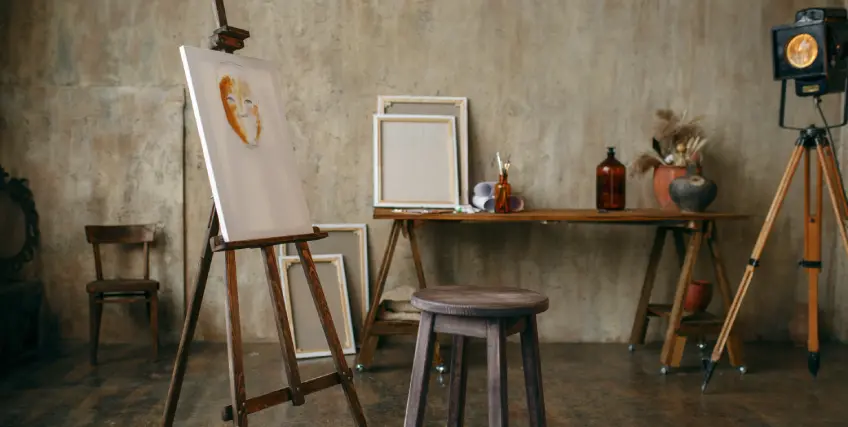Turn Your Art into Opportunity
With Smart Funding
Looking for Business Financing?
Apply now for flexible business financing. Biz2Credit offers term loans, revenue-based financing, lines of credit, and commercial real estate loans to qualified businesses.
Set up a Biz2Credit account and apply for business financing
If you're running an art studio in the U.S., you already know that creativity isn't the only thing you need to stay afloat. Between rent, supplies, payroll, and marketing costs, keeping your business running takes serious money. That’s where art studio business loans come into play.
The reality is that art studios face many of the same financial challenges as any other small business. But they often operate on thinner profit margins and seasonal demand. Whether you're paying for upgraded studio space, hiring new staff, or launching an exhibit, having the right business funding can make all the difference.
And for many entrepreneurs, the upfront costs of opening an art studio can be overwhelming. From specialized equipment financing like kilns and printing machines to monthly cash flow needs, access to reliable capital is key.
Most business owners don’t qualify instantly through traditional banks, especially if they lack a strong credit history or a detailed business plan. That’s why understanding today’s financing options, including EIN loans for business and other small business funding options, is so important.
According to the Small Business Administration, lack of capital is one of the biggest reasons startups fail to survive their first year.
If you need funding to grow or simply keep your doors open, this guide walks you through how to explore, apply, and maximize your chance of securing the right loan for your art studio.
What Do Most Art Studios Use Business Loans For?
Every art business operates differently, but most studios use loans to cover real, ongoing needs. From rent to upgrades, art studio business loans help solve the most common financial pressure points.
1. Rent or Lease for Studio Space
Leasing or owning a dedicated studio space is one of the biggest expenses for any art business. Whether you're downtown or in a co-op building, commercial rent costs keep rising. With the help of art studio business loans, owners can manage lease payments without draining their daily operations. This is especially helpful when signing new leases that require a deposit upfront. According to data from the Federal Reserve, commercial real estate expenses are a major barrier for small creative studios.
2. Buying Art Supplies and New Equipment
High-quality paint, canvas, clay, lighting, and digital tools don’t come cheap. And that’s just the basics. If you teach classes, your supply needs double. A business loan can help you purchase supplies in bulk or invest in durable, long-term equipment financing like kilns or 3D printers. Some entrepreneurs even use short-term loans to bridge gaps during supply chain delays.
3. Payroll and Hiring Staff or Artists
Whether you're hiring part-time assistants, freelance designers, or event managers, staffing your art studio costs money. Many small business owners use loans to cover wages, especially if the business runs classes or events. Payroll loans help ensure you don’t have to dip into savings during slow months. Cash flow problems can disrupt staffing and operations quickly, making small business loans a smart buffer for studios with seasonal revenue patterns.
4. Upgrading Interiors and Studio Amenities
An inviting creative space inspires both artists and clients. But renovations can get pricey. You may want to add better lighting, improve flooring, or install gallery-ready walls. Art studio business loans let you invest in upgrades that enhance your brand and increase the value of your physical location. Plus, some lenders allow loans to cover real estate improvements, making the studio more attractive to buyers, renters, or students.
5. Marketing Campaigns and Social Media Boosts
To sell art, teach workshops, or host gallery events, your studio needs visibility. That’s where business funding helps. From building a website to running paid social media ads, marketing costs add up fast. Most studios don’t have big advertising budgets, which is why many use EIN funding or working capital loans to expand their reach. Smart promotion leads to increased sales, class sign-ups, and private bookings, all essential for long-term growth.
Top Funding Options for Creative Entrepreneurs
Not all art studio business loans look the same. The right fit depends on your credit score, studio revenue, and how soon you need funding. Here are five options many business owners explore.
1. Term Loans
These are classic business loans with set repayment terms, fixed or variable interest rates, and regular payments. Term loans are ideal for studio owners looking to cover a large upfront cost like moving into a bigger location or buying expensive tools. Loan amounts and terms depend on your credit history, annual revenue, and time spent in business. Many studios prefer term loans when planning long-term investments backed by a strong business plan.
2. Business Lines of Credit
A line of credit works like a business credit card - you borrow only what you need, when you need it. It’s great for managing cash flow or surprise expenses like last-minute supply orders or seasonal marketing campaigns. Most lenders require a minimum credit score and revenue history. Compared to fixed loans, lines of credit offer more flexibility for growing studios that want cushions, not commitment.
3. Equipment Financing
Buying equipment outright can kill your budget. Equipment financing helps cover tools like pottery wheels, printers, lighting rigs, or sound systems. The item you’re buying often serves as collateral, so it's easier to qualify, even with a moderate credit score. This type of loan is ideal for studios scaling up their services, adding classes, or expanding into new mediums.
4. SBA Microloans
Backed by the Small Business Administration, SBA microloans offer up to $50,000 in funding for eligible borrowers. These loans often come with lower interest rates and longer repayment periods. They're great for startups, first-time studio owners, and those with limited credit. Having an EIN and a solid business plan strengthens your loan application. You can use the funds for almost anything, such as supplies, rent, or minor renovations.
5. Crowdfunding and Non-Profit Support
For newer studios or creative startups, crowdfunding platforms like Kickstarter or Patreon can help raise capital from your community. Some non-profit groups also offer grants or no-interest loans to support local art initiatives. While not traditional business funding, these tools can act as a launchpad until you're ready to explore formal art studio business loans or other financing tools linked to your EIN funding eligibility.
Why an EIN Matters When Applying for Business Funding
If you're planning to apply for art studio business loans, having an Employer Identification Number (EIN) is more than a formality. It unlocks real opportunities with lenders and separates your personal finances from your business.
Here’s how an EIN supports your funding journey.
1. Helps Establish Business Credit
An EIN is the first step in building credit for your business. Without it, your studio may be viewed as a personal extension of you. Once registered, you can open accounts, apply for credit cards, and start building a trackable credit profile under your business name, not your Social Security Number. This separation is key for borrowers looking for larger loan amounts and better terms in the future.
2. Opens the Door to EIN-Based Business Loans
Some EIN loans for business are only available to entities with a valid EIN. It’s a basic eligibility requirement for many loan programs, especially with non-bank lenders or institutions that provide EIN funding. Without it, you're likely to be limited to personal financing options, which offer less protection and come with higher risk. Studios with EINs have better chances when applying for small business loans or microloans.
3. Needed to Open Business Bank Accounts and Apply for Loans
Many lenders require proof of an EIN to even begin the loan application process. It's also essential to open a business checking account, something you’ll need to track spending, process payments, and receive deposits. This professional setup boosts your credibility and aligns with requirements from both SBA-backed lenders and traditional banks.
4. Builds Trust with Agencies, Vendors, and Investors
Whether you're working with suppliers, landlords, or arts organizations, an EIN signals that your studio is a registered business, not a hobby. It's often required when applying for grants, contracting with the city, or launching a collaborative space. Establishing legitimacy helps when you're ready to pitch for business funding, partnerships, or expand your presence.
Pros and Cons of Taking Out an Art Studio Business Loan
Getting extra capital sounds like a win. But before diving into any business loan, it’s worth looking at both the benefits and the risks.
Here’s what art studio business owners should keep in mind.
Pros of Business Loans for Art Studios
1. Immediate Access to Working Capital
Many studio owners face delays in payment from clients or slow seasonal sales. Art studio business loans help you access fast cash when needed. Whether it’s rent, supplies, or payroll, these loans fill the gap and prevent disruptions. Instead of waiting for sales to come through, you can keep momentum going and focus on growth.
2. Flexible Funding for Multiple Needs
A business loan doesn’t lock you into one use. You can spread it across supplies, salaries, marketing, or utilities. Having this flexibility gives you control over how you grow. It's especially useful for small business entrepreneurs trying to scale or adjust operations without dipping into emergency savings.
3. Builds Credit for the Long Term
Regular repayment on your loan helps you build a strong credit history. This can unlock lower interest rates down the line. It also improves your chances of getting approved for bigger funding or longer-term options. Responsible borrowing is one of the fastest ways to strengthen your business’s financial profile.
Cons to Watch Out For
1. Monthly Repayments Can Strain Cash Flow
Even if your loan helps now, those monthly payments are non-negotiable. Studios with irregular cash flow might struggle during off-peak months. You’ll need to budget carefully to stay on top of repayment, especially if sales aren’t consistent.
2. Interest Rates Vary by Credit and Lender
Your credit score plays a big role in determining your interest rate. If your credit is low or you're a new business, you may pay more in the long run. Always compare financing options and read the fine print before signing any loan agreement.
3. Not All Studios Qualify Easily
Approval isn’t guaranteed. Some lenders require a minimum revenue, years in business, or collateral. If you don’t meet those requirements or lack an EIN or financial projections, you may be offered less favorable terms or be denied altogether.
What Lenders Look for in Your Application
Applying for art studio business loans isn’t just about filling out a form. Lenders want to see proof that you can manage funds, repay on time, and grow your studio. Knowing what they expect can speed up your application process and improve your odds.
1. EIN and Proper Business Registration
Before applying, make sure your studio has an active EIN and the right licenses. Many loan programs won’t even review your file without this. An EIN shows your business is officially registered and separates your personal credit from your business loan. Without it, your chances for EIN loans for business drop dramatically. It’s a basic but essential part of loan eligibility.
2. A Clear Business Plan
Lenders want to know how you’ll use the money. A solid business plan with real financial projections, market goals, and use of funds shows you’re serious. If you don’t have one yet, it’s worth building before applying. A strong plan proves that the loan will drive growth—not just cover gaps. It’s especially useful when applying for SBA loans or longer-term financing.
3. Revenue History or Proof of Sales
You’ll need to show some sort of income, even if you're a newer studio. Bank statements, invoices, or tax returns help prove that your studio has real cash flow. Some lenders also look at monthly revenue trends. This helps them decide if your studio can afford regular repayment, particularly with short-term loans.
4. Credit Score and Payment History
Your credit history plays a big role in whether your art studio business loan gets approved and what terms you’re offered. If your personal or business credit score is low, you may face higher interest rates. Still, some non-profit or microloan lenders may be more flexible. Good credit opens more doors and often leads to better repayment terms.
5. Specific Use of Funds
Be prepared to explain exactly what the funds will cover. Whether you’re upgrading studio space, hiring staff, or buying new equipment, being specific builds trust. It also proves that you’ve thought through how this business funding will directly benefit your growth. Clear intent increases your approval chances, especially for newer entrepreneurs or first-time borrowers.
Smart Ways to Use Your Art Studio Business Loan
You’ve secured the funds. So, now what? Making the most of your art studio business loans starts with knowing where that money creates the biggest impact.
Here are five smart ways to use your loan without wasting a dime.
1. Buy or Upgrade Art Equipment
Use your loan to purchase or upgrade essential gear like pottery wheels, large-format printers, easels, or studio lighting. High-quality new equipment increases output and boosts your brand image. For studios that offer classes, having the right tools also supports enrollment growth. It’s one of the most direct ways art studios reinvest in their success.
2. Hire Staff or Teaching Artists
Bringing on a studio manager, instructor, or assistant gives you more time to focus on your craft. Payroll is a major challenge for small business owners, so using your loan for staffing helps balance operations and expand offerings like workshops or summer camps. Many business owners also see a strong return on this investment through higher enrollment.
3. Launch an Online Store or Website
An online store makes your art more accessible and boosts your revenue potential. Use your funds to build an e-commerce site, create digital inventory, and handle shipping logistics. This digital expansion is essential for studios wanting to sell prints, merch, or offer virtual classes. It also builds brand visibility outside your physical location.
4. Host Community Events or Paid Exhibitions
Use funding to promote community exhibits, artist talks, or seasonal events. This not only draws foot traffic but also creates revenue opportunities. Marketing your events through social media and paid ads can dramatically increase turnout and sales. It’s a high-impact use of business funding that promotes your brand locally and online.
5. Expand or Renovate Your Studio Space
Need a second location? Want to upgrade your flooring or redesign your workshop layout? Art studio business loans can cover real estate improvements that help increase revenue or support more students. These changes enhance customer experience and support your long-term business goals.
Trusted by Thousands of Small Business Owners in America.**
Simply because we get what you go through to build a business you believe in.
**Disclaimer: All stories are real, as told by real business owners. Customers do not receive monetary compensation for telling their stories.
From One Entrepreneur to Another: We Get You
We understand what's behind building a business you believe in.
All stories are real, as told by real business owners. Customers do not receive monetary compensation for telling their stories.



Articles on Loans for Art Studio
Popular Loans for Art Studios: How to Finance Your Creative Space
Running an art studio is a rewarding endeavor, but even the most creative spaces need practical support, especially when it...
How to Start an Art Studio with a Small Business Loan
Artists tend to have big visions. And if you want to expand your creative horizons by opening a studio to support arts education
5 Popular Business Loans Every Art Studio Owner Should Know About
Art fuels emotion. But running an art studio? It demands more than just creativity and passion. Running a stable art studio...
Frequently Asked Questions for the Art Studio Business Loans
1. Can I apply for a business loan without an EIN?
You can apply with a Social Security Number, but having an EIN increases your eligibility for EIN loans for business and builds business credit.
2. What are the best small business funding options for art studios?
Popular options include term loans, lines of credit, SBA microloans, and equipment financing. Each option depends on your credit history, revenue, and specific needs.
3. How long does the loan application process usually take?
Most applications take a few days to a few weeks. The timeline depends on the type of loan, your documentation, and the lender’s process.
4. Can I use my art studio loan for marketing and social media?
Many studio owners use art studio business loans to fund digital ads, build websites, and grow their presence on social media.
5. What if I need funding but have no business credit?
Start with an EIN and apply for microloans or short-term options. Lenders often consider other factors like revenue and your overall business plan.
Frequent searches leading to this page
Term Loans are made by Itria Ventures LLC or Cross River Bank, Member FDIC. This is not a deposit product. California residents: Itria Ventures LLC is licensed by the Department of Financial Protection and Innovation. Loans are made or arranged pursuant to California Financing Law License # 60DBO-35839



